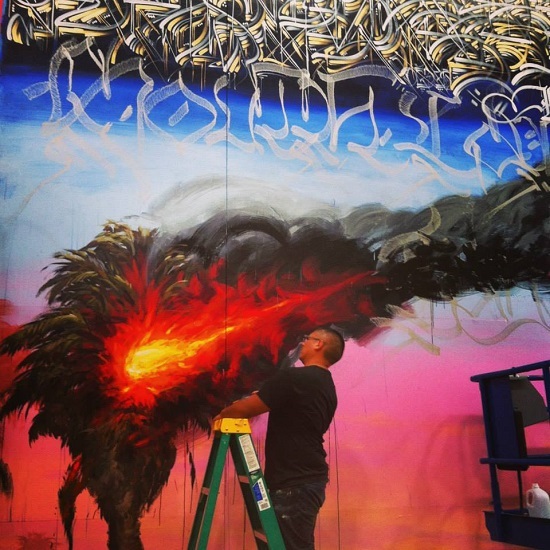Many years ago, art collector, Ed Sweeney, began taking notice of a young man, Juan Carlos Munoz Hernandez, a sculptor and graffiti artist. The work he was doing was unprecedented -- the paintings were colorful, futuristic and geometric, while the sculptures relied more on antiquity by recalling ancient civilizations and incorporating cult images associated with religious traditions of Mayan and Aztec culture. Vehemently he understood the young artist had reached a crossroads where the old and new worlds met, gave life to each other, and coexisted in the nature of his work. As he began to spend more time with him, he came across his crew members from Kill 2 Succeed, (K2S) guys like: Defer, Prime, Gajin Fujita, Big Sleeps, Cab, Cale, Slick, Skept, Kopye, Gabe, and others, which led to a profound relationship with their work, and so began a serious art collection of modern-day graffiti artists that extended to other Los Angeles crews and underground artwork in general -- work that seemed dark, work that seemed progressive. Their energy reminded him of the artists of the early '60s in Los Angeles that he collected, of the Ferus Gallery, the Cool School, whether the dark assemblage work of Ed Kienholz, the experiments with "new age" materials which started the "Finish Fetish" style, and other artists like Billy Al Bengston, Craig Kauffman, Robert Irwin, Ed Moses, Ed Ruscha, Ken Price and Larry Bell. This school of thought came with an attitude -- aggressive, bold and uncompromising, and in Ed Sweeney's opinion, this hadn't existed in Los Angeles until recently, around these K2S guys and a few other crews.
One thing that grasped his attention with these modern artists -- most carried black books with sketches, tags, signatures, drawings, stickers and friendly hit-ups from the graffiti community. Ed Sweeney found it fascinating, the idea that this book transcended politics, rivalries, and criticisms, it was simply a book of experimentation... a book of friendly relations. After several months of pondering, Ed had a brilliant idea but believed it was far-fetched. He thought about creating a voluminous black book, like a piece book these modern artists used, and he thought about donating it to the Getty Research Institute to archive. It would be like a journal with entries from all types of Los Angeles artists from the graffiti community that could always be remembered if this type of artwork perished, or if in thousands of years from now other civilizations would be curious about early 21st century art in Los Angeles, its origins, its collaborative process, and its style. he relied on the strength of two hand styles -- Big Sleeps and Prime. He believed their work was strong enough to champion the cause of the underground lettering style with their collection of typefaces, Neighborhood Offerings. If he couldn't get the Getty Research Institute to agree based on this artwork, then it probably wouldn't come to fruition. That night he sat at his writing desk with one, maybe two beers, and proceeded to send a long email illustrating his vision. He went to bed and forgot it even happened, that it was just some random haphazard idea and nobody would take it seriously. But not long after, the Getty Research Institute responded favorably, then David Brafman, curator of rare books and manuscripts, and Ed Sweeney were examining liber amicorum manuscripts, (latin for "book of friends") ranging from the 1500s to the 1700s, and soon the call went out to artists to make their contribution to the Getty Black Book, the book of friends.
Shortly thereafter, David Brafman brought this project up to the El Segundo Museum of Art (ESMoA), a new museum but more like an experimental laboratory with an artist-in-residency program, already recognized for its maverick approach to art exhibitions, which they refer to as experiences, and helping serve as an agent of change in the City of El Segundo, historically known for its closed and conservative nature. ESMoA was fascinated by the project and thought it a fascinating idea to recreate a real-life book of friends with a few crews working side-by-side with several of their friends assisting in the development of the wall. The museum has a rectangular shape, enough for three crews on each side, with two book ends that would close the narrative, even letting it bleed out to the floor, and all filled with our Los Angeles graffiti writers and some tattoo artist's work. Never in the history of Los Angeles has a project of this magnitude ever been facilitated for Los Angeles artists of this genre. Education Specialist of ESMoA, Holly Crawford, has since developed a summer art camp for different fields such as: printmaking, mural design, book publishing, tattoo demonstration, lecture series, guest curators, and others. It is only the beginning of what's to come, not only in El Segundo with its creation of a new art walk, outreach program and random transformation of buildings, but also for the City of Los Angeles and the way we perceive work that originated in this city from a cold era, work that is dark and progressive. We should all thank people like Bernhard Zünkeler, and Brian and Eva Sweeney of ESMoA, and other pioneers that are opening up the doors to show the world that art plays a pivotal role in our lives, especially the type that is heavily criticized because the result is the reality of the cityscape, and many don't like facing the harsh truths of the fragmented city. Please support and join the art community for the grand opening of Scratch at ESMoA on Sunday June 8th at 10:00am.
Photo credit: ESMoA 2014
